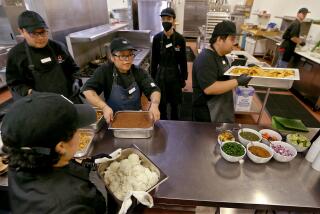Back-to-school lunches for celiac sufferers

The start of school carries extra anxiety for the parents of kids who have celiac disease or an intolerance for gluten. Packing lunch can be a challenge, as can getting everyone educated about what foods could cause problems.
Packing lunch “is almost a topic of obsession for me,” says Lucy Gibney, whose 9-year-old son cannot eat wheat or dairy products.
Especially for parents who are sending children to school for the first time, the cafeteria can seem like a minefield of problems. But Gibney says many organizations have developed guides for families to negotiate food at school.
For children with special dietary needs, “preparing ahead is really important,” says Gibney.”You don’t want to show up on the first day with these special needs.”
Many schools have stopped serving foods that contain tree nuts or peanuts, and some schools have banned them altogether. Families need to decide whether the child can eat school food and perhaps avoid certain products that cause problems, or whether it’s necessary for the child to take lunch and snacks to school. Gibney says she packs a lunch, and because of the severity of her son’s issues, she uses a lunchbox designed so that he doesn’t have to put his food on the table.
(The lunchbox company is Laptop Lunches, and the lunchbox is like a bento box, with several smaller compartments.)
And the good news about many food allergies or intolerances: Most fruits and vegetables are OK, as well as healthful. Hummus and cheese also are good options.
There are many brands of gluten-free bread or tortillas on the market, but Silvana Nardone says in the National Foundation for Celiac Awareness newsletter that parents might try making a wrap with lettuce leaves instead.
Gibney says that when she talks to groups, she has a “3 Ps” approach: Prepare, prevent and participate.
“There can be disappointment for parents if they approach the school and the school is not prepared,” she says. “We want to feel that the school is all-knowing on all things pertaining to kids. And they’re not.”
In fact, the parent might be the “expert.”
“You might know more about this than the school knows, so realize you are going to be the leader. Pair up with whoever you need to – the nurse, the principal. … You have to participate in the process,” Gibney says.
Gibney packs her son a sandwich, fresh vegetables, healthy chips and a package of her company’s cookies. She started a company called Lucy’s, which sells cookies and cakes that are gluten-free and made without milk, eggs, peanuts or tree nuts.
Elementary school kids often like to eat the same lunch day after day, so the job becomes fairly easy once an acceptable menu is decided. For older students, lunch can be more challenging.
They often don’t want to carry a lunchbox, an ice pack or a thermos. And in high school, lunchtime might be devoted to club meetings or theater practice.
“When you have a high school who is trying to be cool, the challenges are bigger,” Gibney says.
In their lunches, bars or other healthful packaged foods are a good option, she said. “That age likes branded and packaged things.”
At any age, if kids don’t eat all their food at school, she says, make sure a hefty, well-balanced breakfast and dinner are served at home, and keep food in the house that’s good for snacking.
Here are some resources Gibney recommends:
Food Allergy Research and Education
National Foundation for Celiac Awareness
Navigating the School System
ALSO:
Mary.MacVean@latimes.com
Twitter: @mmacvean
More to Read
Eat your way across L.A.
Get our weekly Tasting Notes newsletter for reviews, news and more.
You may occasionally receive promotional content from the Los Angeles Times.







